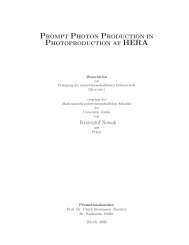Master Thesis Effect of vortex shaking on the ... - Physik-Institut
Master Thesis Effect of vortex shaking on the ... - Physik-Institut
Master Thesis Effect of vortex shaking on the ... - Physik-Institut
You also want an ePaper? Increase the reach of your titles
YUMPU automatically turns print PDFs into web optimized ePapers that Google loves.
<strong>on</strong> <strong>on</strong>e single crystal <strong>the</strong> difference in resistivity between a melting transiti<strong>on</strong><br />
where vortices are held in pinning centers and <strong>on</strong>e where <strong>the</strong>y are in equilibrium.<br />
The technique works as follows: C<strong>on</strong>sider a thin superc<strong>on</strong>ducting strip that<br />
fills <strong>the</strong> space |x| ≤ w, |y| < ∞, |z| ≤ d/2 with d ≪ w, and a c<strong>on</strong>stant homogeneous<br />
external magnetic field H a which is directed al<strong>on</strong>g z, while an ac<br />
magnetic field h ac = h cosωt is applied al<strong>on</strong>g x, perpendicular to H a and to<br />
<strong>the</strong> shielding currents in <strong>the</strong> sample. We make <strong>the</strong> Bean assumpti<strong>on</strong> that<br />
<strong>the</strong> critical current density j c does not depend <strong>on</strong> <strong>the</strong> local inducti<strong>on</strong> B [19].<br />
The currents flowing in <strong>the</strong> critical state <str<strong>on</strong>g>of</str<strong>on</strong>g> <strong>the</strong> strip generate a n<strong>on</strong>uniform<br />
distributi<strong>on</strong> <str<strong>on</strong>g>of</str<strong>on</strong>g> <strong>the</strong> magnetic inducti<strong>on</strong> B z (x), as <strong>the</strong> self-field <str<strong>on</strong>g>of</str<strong>on</strong>g> <strong>the</strong> currents<br />
adds to h ac <strong>on</strong> <strong>the</strong> upper (or lower) plane <str<strong>on</strong>g>of</str<strong>on</strong>g> <strong>the</strong> strip and reduces it <strong>on</strong> <strong>the</strong><br />
opposite plane. As a result, <strong>the</strong> applied ac field periodically tilts <strong>the</strong> vortices<br />
in this state. However, at each point x with a n<strong>on</strong>zero sheet current J(x)<br />
(<strong>the</strong> current density integrated over <strong>the</strong> thickness d), <strong>the</strong> tilt is not symmetric<br />
relative to <strong>the</strong> central plane <str<strong>on</strong>g>of</str<strong>on</strong>g> <strong>the</strong> strip z = 0, and during each cycle <str<strong>on</strong>g>of</str<strong>on</strong>g> <strong>the</strong><br />
ac field, <strong>the</strong> asymmetry leads to a drift <str<strong>on</strong>g>of</str<strong>on</strong>g> vortices towards <strong>the</strong> center x = 0<br />
<str<strong>on</strong>g>of</str<strong>on</strong>g> <strong>the</strong> strip. This shift tends to equilibrate B z (x), and it also generates a dc<br />
electric field which decreases J(x). When J(x) reaches zero, <strong>the</strong> asymmetry<br />
disappears, and <strong>the</strong> process stops[16].<br />
Unfortunately, <strong>the</strong> above treatment is <strong>on</strong>ly valid for currents flowing perpendicular<br />
to <strong>the</strong> ac field. As it is very unlikely to have an almost infinitely<br />
l<strong>on</strong>g and thin superc<strong>on</strong>ducting sample for <strong>the</strong> experiments, it is necessary to<br />
treat l<strong>on</strong>gitudinal <str<strong>on</strong>g>shaking</str<strong>on</strong>g>, with currents flowing parallel to <strong>the</strong> ac field as<br />
well. This is somewhat more complicated. We have now again <strong>the</strong> same setting<br />
as above, but this time h ac is parallel to <strong>the</strong> sheet current J which flows<br />
in y directi<strong>on</strong>. The vortices are again tilted by <strong>the</strong> ac field, this time from<br />
z towards <strong>the</strong> y directi<strong>on</strong>. This happens because <strong>the</strong> critical-current density<br />
j c (z) = [j cx (z), j cy (z), 0] has a n<strong>on</strong>zero x comp<strong>on</strong>ent which is antisymmetric<br />
in z, j cx (z) = −j cx (−z). Thus, j c (z) = j c (z)[−sinφ(z), cosφ(z), 0] flows at an<br />
angle φ(z) to <strong>the</strong> y axis. Since <strong>the</strong> Lorentz force applied to an infinitesimal<br />
element <str<strong>on</strong>g>of</str<strong>on</strong>g> <strong>the</strong> <str<strong>on</strong>g>vortex</str<strong>on</strong>g> is normal to j c (z), and <strong>the</strong> element drifts al<strong>on</strong>g this<br />
force, <strong>the</strong> tilt al<strong>on</strong>g y is always accompanied by a small drift al<strong>on</strong>g x. This<br />
drift is independent <str<strong>on</strong>g>of</str<strong>on</strong>g> <strong>the</strong> sign <str<strong>on</strong>g>of</str<strong>on</strong>g> h ac , and hence, under <strong>the</strong> influence <str<strong>on</strong>g>of</str<strong>on</strong>g> an<br />
ac field, <strong>the</strong> <str<strong>on</strong>g>vortex</str<strong>on</strong>g> will drift in <strong>the</strong> directi<strong>on</strong> <str<strong>on</strong>g>of</str<strong>on</strong>g> [J y × H z ] by an oscillating<br />
screwlike moti<strong>on</strong>. The mechanisms are fur<strong>the</strong>r explained in Figures 3 and 4.<br />
2.3 Sample<br />
The sample used for this first experiments was a NdBa 2 Cu 3 O 7−d crystal,<br />
optimally doped and twinned. Its critical temperature was ≈ 96.7 K. Nd-<br />
7
















